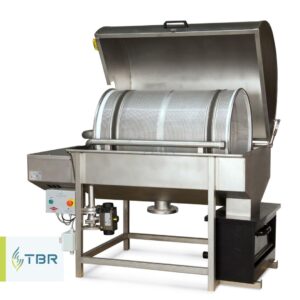
How is it possible in this day and age that one third of the world’s population does not have access to clean drinking water?
Water scarcity
Water scarcity is a word that we hardly know in the Netherlands. Water scarcity is caused, among other things, by water wastage. If we consume less water and use water-saving solutions, we can contribute to a better water environment.
What are we doing to reduce water scarcity?
The people at TBR are specialized in saving water and reusing energy. Our sustainable solutions have led to a water consumption reduction of 3,000,000 m3 in 2021, which equates to 3,000,000,000 litres of water per year in the industry and we are proud to share those figures.
Engineering
By making connections in existing or new processes, we can optimize water consumption, so that less water is needed. It is important not only to quantify the water, but also to qualify it. The quality of the wastewater determines the level at which it can be reused. An example of technology that we use for this are our filters.
An example from the laundry industry
Where you use 20 litres of water per kilogram of laundry at home, this has been greatly reduced by applying the latest techniques in the industry. In the past 20 years, so much has changed and become more sustainable that by using our recovery tanks and pump sets, only 2 litres of water are used per kilogram of laundry.
Filter and disinfection
If the wastewater is polluted to a high degree, we apply various filtering and cleaning techniques. Depending on the degree of contamination and application, contaminants are removed and the filtered water can be disinfected if necessary.
WX LintRotor

There are over 250 ‘WX LintRotors’ around the world. These filters filter an average of 6 m3 per hour of wastewater, which means that more than 1500 m3 per hour are filtered. A productivity of 2,000 hours per year means a reduction in water consumption of at least 3 billion litres of water per year!
Steam
We have also developed various solutions to optimize steam-driven processes. By applying our vapor steam systems, waste condensate is reused as low-pressure steam to heat processes. For example, there are more than 100 ‘STX vapor steam systems’ all over the world that recover an average of 2.5 m3 per hour of waste condensate per unit. This means that 250 m3 is recovered per hour. With a productivity of 2,000 hours per year, this results in a reduction in water consumption of at least 0.5 billion litres of water per year!
Together, this adds up to approximately 3.5 billion litres of water per year.
Good to know
We specialize in reducing water consumption, gas consumption and energy consumption for industrial companies. In this article we will discuss water consumption, because World Water Day is on the agenda.
How did World Water Day come about?
In 1993, the United Nations declared March 22 as World Water Day. A day for creating more awareness about issues surrounding water.
SDGs
The 193 member states of the United Nations (UN) have set the development agenda for 2015 – 2030. The agenda consists of 17 goals. These SDGs are called ‘Sustainable Development Goals’ in full, but are often abbreviated to SDGs. They apply in all countries and to all people. We will highlight one of these goals, namely number 6: Clean water and sanitation for everyone.
A short explanation in this video
What can we do?
Reuse
- Filter
- Disinfect
- Cleaner discharge
TBR Solutions takes responsibility and stands up for minorities. We live in an age of technological marvels. We are on track to make reusable space rockets, self-driving cars, robot workers and artificial intelligence.
So, how is it possible that we are not on track to ensure that everyone in the world uses water sustainably? Water means different things to different people. For some, the use of clean water is the most normal thing in the world, while for others it is not.
Together
It is normal for us to have clean drinking water and to wash our hands with it. With our technology and knowledge, we reduce water consumption by filtering and reusing waste water. Together with our clients, we can ensure that we make a difference. Or even stop discharging waste water.
Want to know more? Contact us.
Waste water figures
The 2021 SDG 6 report on wastewater provides an overview of global progress towards Sustainable Development Goal 6. It builds on the most recent data available for the global indicators.
Read more: https://www.unwater.org/publications/progress-on-wastewater-treatment-631-2021-update/
#WorldWaterDay
Source: Worldwaterday.org
